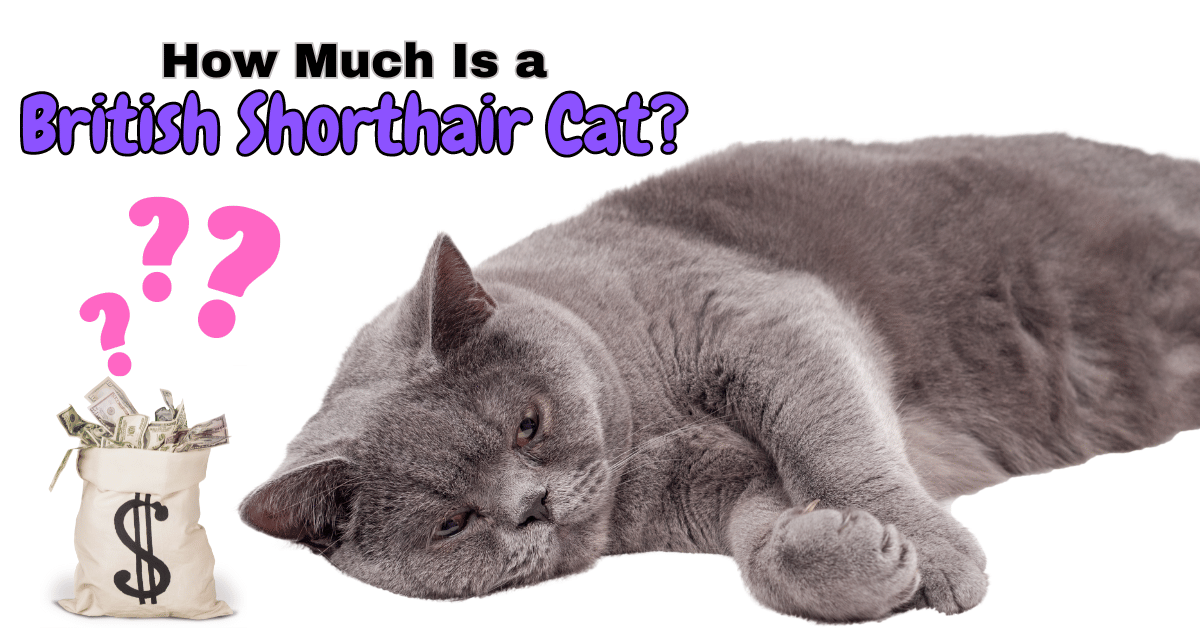This post contains affiliate links and I will be compensated if you make a purchase after clicking on my links.
Exploring How Much is a British Shorthair Cat: From Purchase to Care
British Shorthair cats are known for their round faces, plush coats, and easygoing personalities. These charming felines have captured the hearts of many cat lovers worldwide, making them one of the most sought-after breeds. Owning a British Shorthair cat is by no means cheap and would require more from you in the long run.
This is not just about the initial cost; you have to make sure that you are aware and capable of maintaining your British Shorthair like you would any other pet. From initial expenses like purchase or adoption fees to ongoing costs such as food, grooming, and medical care, we’ll explore all the financial aspects to help you make an informed decision.
Initial Costs of a British Shorthair Cat
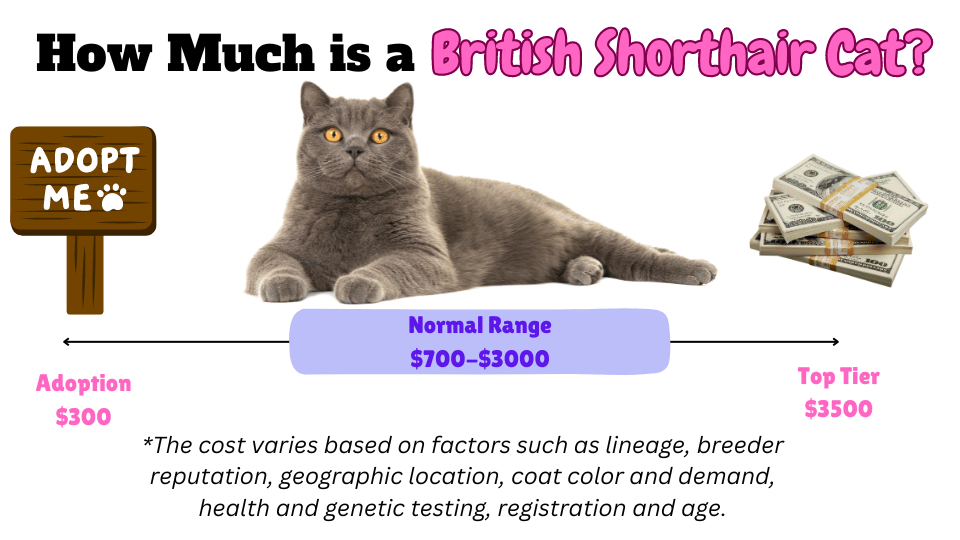
Adoption Fees
Adopting a British Shorthair cat is often a more budget-friendly option, with fees typically ranging from $100 to $300. This cost usually includes initial veterinary care and essential services such as vaccinations and spaying/neutering. Before finalizing the adoption, it’s important to ask for the records and details of your future pet to ensure they have received the necessary care.
Breeder Costs
If you decide to purchase a British Shorthair from a reputable breeder, be prepared to invest between $700 and $3,500 for a kitten. The price can vary depending on several factors:
- Age: Kittens usually cost more than adult cats due to their higher demand and longer potential lifespan. Younger cats require more initial care, which can add to the price, while older cats may come at a lower cost but might require more immediate medical attention.
- Lineage: Cats with superior pedigrees and those bred for show purposes are generally more expensive. Pedigreed cats often have better temperaments and health conditions, making them a valuable investment.
- Breeder Reputation: Established breeders with a good reputation often charge higher prices due to their experience and the quality of care they provide.
- Location: Prices may vary based on geographic location and local demand.
- Coat Color and Demand: Certain coat colors and patterns may be more desirable, influencing the price.
- Health and Genetics: Reputable breeders often conduct genetic tests and health checkups to ensure the kittens are healthy, adding to the cost.
- Registration: Responsible breeders register their cats with registries such as the Cat Fanciers’ Association and The International Cat Association. The cost of these registrations is often passed on to the buyer, contributing to the overall price.
Other Initial Expenses
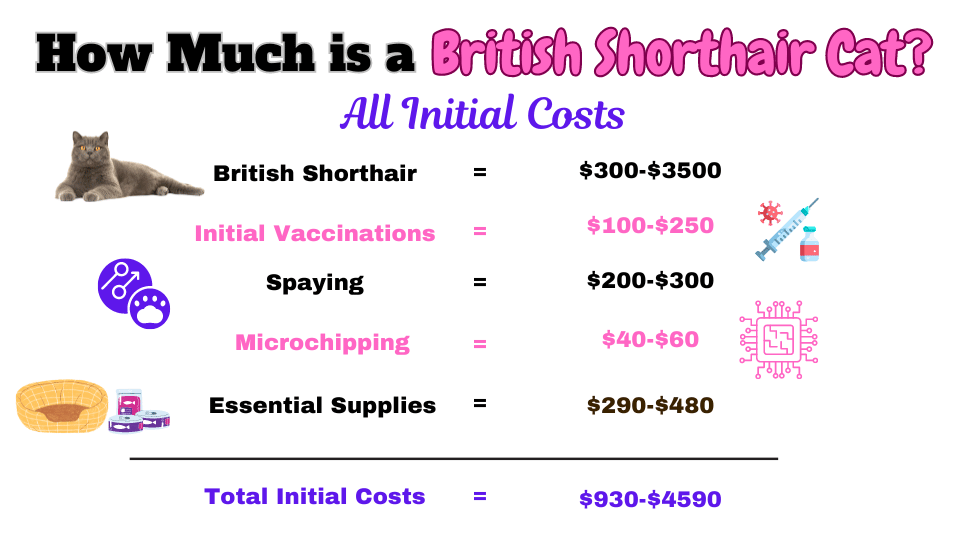
When considering how much a British Shorthair cat costs, it’s essential to factor in the initial medical expenses, as well as basic supplies like a litter box, bed, scratching post, food, and water bowls, to ensure your new feline friend starts off on the right paw.
Tip: The initial medical costs can be null or minimal depending on where you adopted or bought the British Shorthair, as there is a high chance they were already covered.
Initial Vaccinations and Visit
The first round of vaccinations, along with an initial vet visit, is crucial for your British Shorthair’s health. This typically includes vaccinations for Feline Herpes Virus 1, Feline Calicivirus, Feline Panleukopenia, and Rabies.
Price: $100 – $250
Spaying
Neutering or spaying your British Shorthair is highly recommended to prevent health issues and unwanted litters. These procedures offer significant health benefits, such as reducing the risk of certain cancers, reduce behavioral issues and eliminating the chances of reproductive system diseases.
Price: $200-$300
Microchipping
Microchipping is a vital step for ensuring your cat’s safety. This small, permanent identification chip can help you locate your pet if they ever get lost – it’s a small price for peace of mind.
Price: $40-$60
Essential Supplies and Equipment
Before bringing your British Shorthair home, you’ll need to invest in several essential supplies. Here’s a breakdown of the initial costs:
- High-Quality Food & Treats: Expect to spend around $40-50 per month on premium food and treats for your British Shorthair.
- Food and Water Bowls: Basic bowls will cost around $25, but more advanced options like water fountains or smart feeders will add to the price.
- Litter Box: A good quality litter box can cost between $50 and $150.
- Litter: Monthly supply of litter ranges from $15 to $30.
- Cat Bed: A comfortable bed for your cat can cost up to $50.
- Grooming Essentials: Budget up to $50 for essential grooming tools like a brush, toothbrush, and nail clippers.
- Scratching Posts and Toys: These are essential for your cat’s mental and physical stimulation, costing between $50 to $100.
- ID Collar: Ensuring your cat has an ID collar for safety, which can be around $10 to $25.
Price: $290-$480
Ongoing Expenses of a British Shorthair Cat
Owning a British Shorthair cat involves recurring monthly expenses to keep your pet happy and healthy.
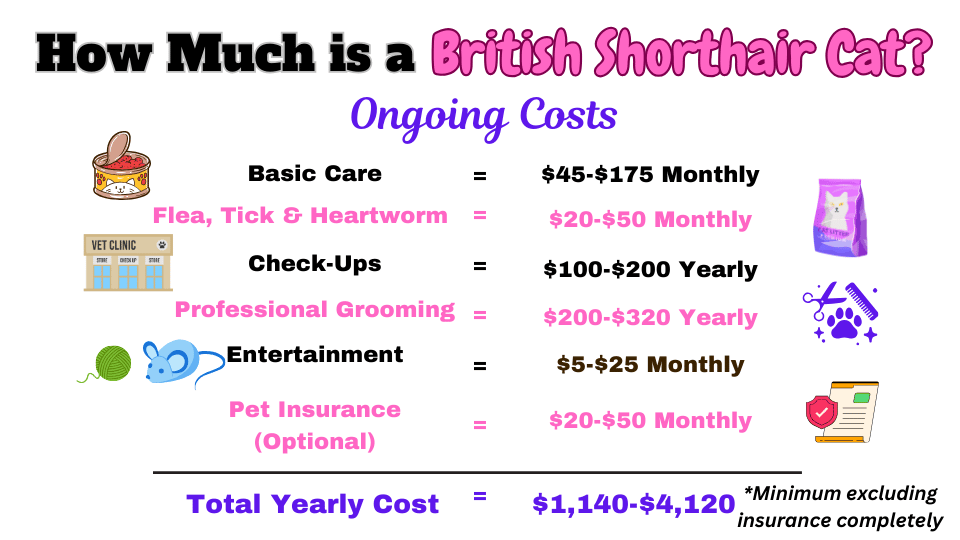
Food and Treats
Feeding your British Shorthair high-quality food is essential for their well-being. Expect to spend around $40 to $60 per month on premium cat food, and don’t go for less than $30 to ensure quality. If your kitty requires a prescription diet for options like specialty kidney and urinary diets, be prepared to shell out up to $150 per month.
Make sure the food meets the American Association of Feed Control Officials (AAFCO) nutritional requirements to keep your feline friend in tip-top shape.
Price: $30-$150
Litter Maintenance
Maintaining a clean and hygienic litter box is essential for your British Shorthair’s health and comfort. Typically, cat litter should be changed at least once a week, but more frequent changes might be necessary depending on the type of litter and the number of cats you have.
Price: $15-$25
Flea, Ticks and Heartworms Prevention
For keeping those pesky fleas, ticks, and heartworms at bay, British Shorthair cats have a variety of defense options—from tablets and powders to sprays. These preventive measures are essential for maintaining your furry friend’s health.
Price: $20 to $50 a month
Annual Check-ups
Regular vet consultations and yearly check-ups are crucial for early diagnosis of severe health problems. These visits should include bloodwork and ensuring your cat is up-to-date with core vaccines. Staying proactive with these appointments helps avoid expensive treatments later and can significantly extend your cat’s lifespan.
Price: $100-$200
Ongoing Grooming Supplies
While we already included grooming supplies as an initial cost, these expenses are very minimal in the long run. If you buy good quality tools initially, you should only need to replace them rarely, perhaps once a year. The ongoing cost mainly involves replenishing consumables like toothpaste, which is relatively negligible.
Price: $Null
Quarterly Professional Grooming
Occasional grooming sessions at a pet salon can help keep your cat’s coat in top condition. Depending on how dirty their coat gets, it’s ideal to take them to a professional groomer or have a mobile groomer come to your home every quarter. This ensures your British Shorthair’s coat stays clean and healthy.
Price: $50 to $80 per session.
Entertainment and Environment Maintenance
British Shorthair cats are not the most active and energetic, but they still require daily playtime and interaction with you. Ideally, you should spend at least 30 minutes a day engaging with your cat. To keep things interesting, it’s a good idea to buy different types of toys or subscribe to a cat subscription box that delivers new toys and treats regularly.
Price: $5 to $25 per month.
Pet Insurance (Optional)
Pet insurance can help cover unexpected medical expenses and provide peace of mind. The cost will depend on the coverage you choose, with options ranging from basic accident-only plans to comprehensive policies that cover routine care, surgeries, and chronic conditions. While the price varies, investing in pet insurance can save you a lot of money in the long run by offsetting costly vet bills.
Price: $20-50$ Monthly
Additional Considerations
Unexpected Medical Expenses
Cats, like humans, can have unexpected health issues. It’s wise to have a savings buffer to cover emergencies and potential medical treatments. Veterinary emergencies can be costly, so setting aside funds, especially if you didn’t get pet insurance, is crucial to ensure your cat receives the best care without financial stress.
Price: Varies
Pet Sitter and Boarding
If you travel, you’ll need to consider the costs for pet sitters or boarding. Whether you have someone come to your home or take your cat to a boarding facility, the price will vary. However, cats generally prefer to stay in their familiar home environment, which makes pet sitting an ideal option.
Price: $15 to $40 per night
Furniture Damage
Cats love to scratch, and sometimes your furniture becomes their favorite target. Be prepared for potential repair or replacement costs due to cat-related damage. Investing in good scratching posts and deterrents can help minimize these expenses.
Price: $100 Yearly
Cost-Saving Tips for British Shorthair Owners
Owning a British Shorthair cat can be costly, but there are ways to manage and reduce expenses without compromising on quality.
Negotiate with Breeders
In the unlikely case that breeders didn’t vaccinate or provide initial medical care for the British Shorthair, you can negotiate a better price. Always ensure you are aware of what has and hasn’t been done before finalizing the purchase.
Dry Food is Cheaper
While dry food is generally cheaper, it’s not ideal as the main food source on a daily basis. British Shorthairs need wet food due to its high water content, which helps keep them hydrated. However, mixing dry food with wet food a few times a week can be a good way to balance costs while still providing necessary hydration.
High-Quality Items
Investing in durable grooming tools and toys can save you money in the long run. High-quality items may have a higher upfront cost but tend to last longer and perform better, ultimately saving you from frequent replacements.
Health Monitoring
Regular veterinary visits help catch health issues early, potentially avoiding more expensive treatments down the line. Early detection and preventive care are key to managing your cat’s health efficiently and economically.
DIY Treats and Toys
Making homemade treats and toys is a fun and cost-effective way to keep your British Shorthair entertained and satisfied. There are plenty of DIY recipes and tutorials online that can help you create nutritious treats and engaging toys.
Bulk Purchasing
Buying cat food, litter, and other supplies in bulk can significantly reduce costs. Many suppliers offer discounts for large orders, and you might also qualify for free shipping, adding to your savings.
How Much is a British Shorthair Cat? The Full Financial Commitment
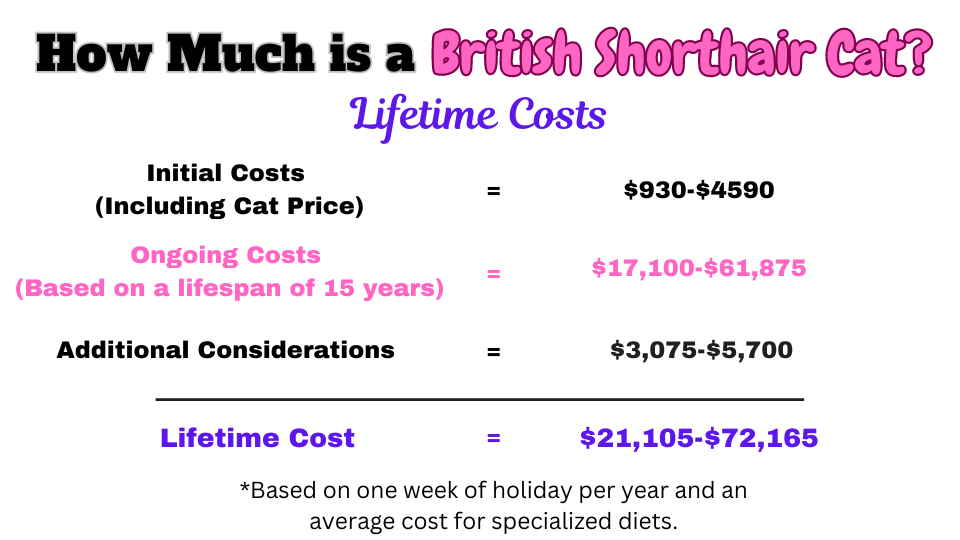
Owning a British Shorthair cat is a rewarding experience, but it’s important to understand the financial commitment involved.
The total cost of owning a British Shorthair can vary widely due to numerous factors. Costs range from a bare minimum of approximately $21,105 to a maximum of around $72,165 particularly if you opt for premium insurance, specialty food, and the most expensive options available
While you can definitely spend less, these figures are reasonable estimates, and chances are your actual expenses will fall somewhere between these two extremes.
Meet Sean, a fintech whiz with a penchant for pet purrs and blockchain buzz. After a decade of fintech feats, Sean’s tech talents leaped from ledger lines to litter lines, driven by a passion for pets and a vision for a more connected pet care community. With three critter companions as co-pilots, Sean launched this blog to share a treasury of pet-friendly tech tips and tales.

